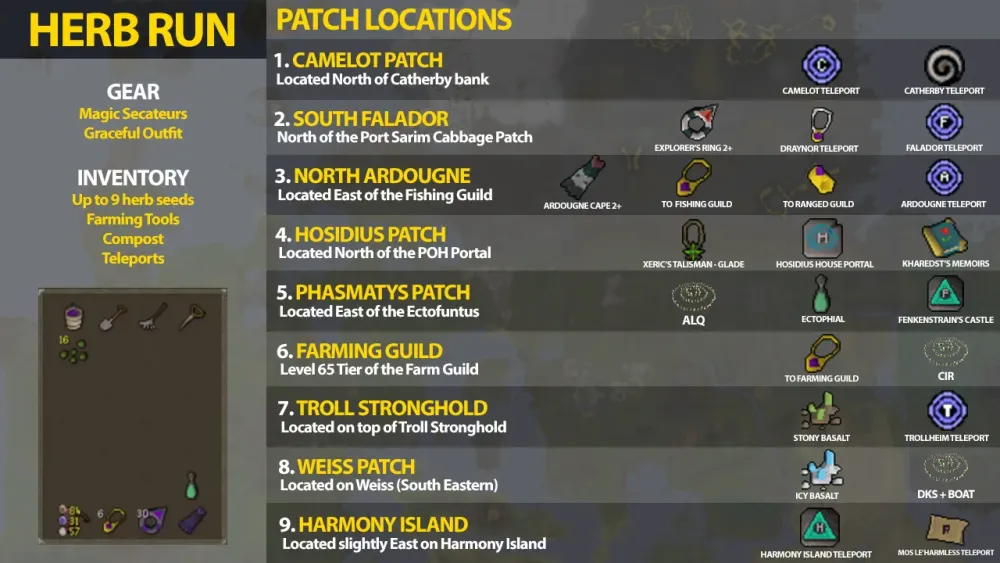Your cart is empty
Maximizing Herb Yields: The Best Patch for Herb Farming in OSRS

Herb farming in Old School RuneScape (OSRS) is a lucrative and engaging activity that allows players to cultivate various herbs for potions, crafting, and profit. With the right strategies and knowledge, players can maximize their herb yields, ensuring a steady supply for both personal use and trade. This guide will delve into the essential aspects of herb farming, focusing on the importance of selecting the optimal herb patch to enhance your farming efficiency and productivity.
Selecting the right herb patch is crucial for maximizing your yields in OSRS. Several factors influence the effectiveness of a patch, including location, proximity to banks, and ease of access. The most commonly used herb patches are located in various regions of Gielinor, each offering unique advantages and disadvantages.
One of the best patches for herb farming is the patch located in the Falador herb patch, situated just north of the city. This patch is conveniently close to a bank, making it easy to store your harvested herbs. Additionally, the Falador patch is near a farming guild, which can provide further benefits, such as access to additional resources and farming expertise.
Another excellent option is the patch located in the Hosidius House in Zeah. This patch is particularly advantageous for players who have unlocked the area through the quest “The Client of Kourend.” The Hosidius patch has a unique benefit: the nearby compost bin allows players to use compost to enhance their herb yield. Moreover, the quick teleport options available to this area, like the Kourend Castle Teleport, make it a highly efficient choice for herb farming.
Other notable patches include the patch in Taverley, which is close to a bank and the nearby farming guild, and the patch in the Lletya area, which is convenient for players who have completed the “Regicide” quest. The Lletya patch also offers the benefit of having access to a nearby spirit tree, allowing for rapid travel to other locations.
When choosing a patch, consider the types of herbs you want to grow. Some patches may be more suitable for specific herbs, depending on their growth requirements and your farming level. Additionally, always keep in mind the use of supercompost or ultracompost to increase your yield and reduce the chance of diseases affecting your crops.
Ultimately, the best patch for herb farming in OSRS is subjective and should align with your play style, available resources, and proximity to other essential areas. By carefully selecting your herb patch and utilizing the right farming practices, you can maximize your herb yields and enjoy the benefits of successful herb farming.
Optimal Herbs to Grow in Your Patch

When it comes to maximizing your herb yields in Old School RuneScape (OSRS), choosing the right herbs is crucial. Some herbs are more profitable and easier to grow than others. Here’s a rundown of the best herbs you should consider planting in your herb patch:
- Ranarr Weed: This is one of the most sought-after herbs in the game. It’s used for making Prayer Potions and is always in demand.
- Snapdragon: Another popular choice, Snapdragons are utilized in making Super Restore Potions, making them valuable in the market.
- Torstol: Known for its high value, Torstol is essential for making the most potent potions. However, it requires a higher Farming level to grow.
- Cadantine: Often overlooked, Cadantine is useful for making super energy potions. Its profit margin is decent, making it a solid choice.
- Grimy Herbs: Consider growing a mix of grimy herbs like Guam and Marrentill for lower-level players. They are easy to grow and can provide a steady income.
Ultimately, the best herbs for your patch depend on your Farming level, market trends, and personal goals. Keep an eye on the Grand Exchange to see which herbs are selling well.
Factors Affecting Herb Growth
Growing herbs in OSRS isn’t just about picking the right ones; there are several factors that can impact their growth. Understanding these factors can help you optimize your farming strategy:
| Factor | Description |
|---|---|
| Farming Level: | Your Farming level determines which herbs you can plant. Higher-level herbs yield more profit but require more experience to grow. |
| Patch Location: | Herb patches are found in various locations across Gielinor. Some patches are more convenient for travel and have nearby banks for quick access. |
| Weather Conditions: | While OSRS doesn’t have real-time weather, using tools like the Farming Guide can help you understand the best times to plant. |
| Pest Control: | Herbs can be affected by pests. Make sure to check your patches regularly and use compost to protect against them. |
| Compost Usage: | Using compost can increase the yield of your herbs. Regular and super compost provide better results, so consider using them to maximize growth. |
Pay attention to these factors, and you’ll be on your way to a thriving herb farm in no time!
5. Best Farming Methods for Maximum Yield
When it comes to maximizing herb yields in Old School RuneScape (OSRS), the right farming methods can make a world of difference. Here’s a breakdown of the most effective techniques to consider:
- Herb Patch Locations: Utilize the best herb patch locations, such as the ones at:
- Planting Sequence: Opt for a strategic planting sequence. For instance, plant higher value herbs like Torstol and Snapdragon for better profits.
- Utilize the Farming Skill: Ensure you have a good Farming level; this allows you to plant higher tier herbs. Aim for at least level 38 to grow Ranarr herbs, a popular choice.
- Watering: Always remember to water your herbs right after planting. This keeps them healthy and improves their yield.
- Super Compost: Use super compost to increase the yield of your herbs, making your farming efforts even more fruitful.
By combining these methods, you can significantly boost your herb yield, maximizing your profits and efficiency in the game.
6. Using Fertilizers for Improved Herb Growth
Fertilizers can be a game-changer when it comes to enhancing herb growth in OSRS. Here’s how you can leverage fertilizers for better yields:
- Types of Fertilizers: Familiarize yourself with the different fertilizers available:
- Compost: Increases growth rates.
- Super Compost: More effective than regular compost, it significantly boosts yields.
- Ultra Compost: The best option, providing maximum yield and reducing disease risk.
- Application: Apply fertilizers right after planting your herbs. This ensures they benefit from the nutrients as they grow.
- Benefits: Using fertilizers not only increases your yield but also decreases the likelihood of diseases, giving you a more reliable harvest.
- Cost vs. Yield: While fertilizers can be an added cost, the increased herb yield often outweighs this expense, making it a worthwhile investment.
Incorporating fertilizers into your herb farming routine is essential for those looking to maximize their harvests and profits in OSRS. Happy farming!
7. Herb Farming Gear and Inventory Setup
When it comes to maximizing your herb yields in Old School RuneScape (OSRS), having the right gear and inventory setup is crucial. Here’s how you can ensure you’re fully equipped for your herb farming adventures.
Essential Gear:
- Trowel: This is a must-have tool for planting seeds in your herb patches. Make sure to keep it in your inventory at all times.
- Seed Dibber: Necessary for planting herb seeds. This handy tool ensures that you can quickly get your seeds into the ground.
- Watering Can: While not always required, a watering can is useful if you’re dealing with crops that need watering. Remember to fill it up!
- Farming Outfit: Wearing pieces of the Farming outfit can provide you with a bonus to your yield. Look for the farmer‘s hat, shirt, and trousers.
- Amulet of Nature: This amulet is fantastic for reducing the time it takes for your herbs to grow, making it a worthwhile investment.
Inventory Setup:
Your inventory should be set up for efficiency. Here’s a simple layout:
- 1x Trowel
- 1x Seed Dibber
- 1x Watering Can (if needed)
- Herb Seeds (as many as you can carry)
- Any tools or items related to herb protection, like Supercompost or plant cure items.
By ensuring your gear and inventory are optimized, you’ll be well on your way to maximizing your herb yields!
8. Tips for Efficient Herb Harvesting
Harvesting herbs efficiently in OSRS can significantly boost your farming experience and profits. Here are some practical tips to help you streamline your herb farming process.
Planning Your Route:
Before you even step foot in the fields, take a moment to plan your route. Here’s a quick checklist:
- Identify the closest herb patches to your bank.
- Map out a circular route that allows you to visit multiple patches without backtracking.
Use Teleports Wisely:
Utilizing teleportation can save you a lot of time. Here are some great teleport options:
- Fairy Rings: Great for accessing various locations quickly.
- Home Teleport: Use it to return to your house and then teleport to nearby patches.
- Teleportation Tablets: Consider crafting or buying these for quick access to farming locations.
Utilize Supercompost:
Using Supercompost can greatly improve your herb yields. Here’s how:
- Mix normal compost with waste items (like fruits and vegetables) to create Supercompost.
- Apply it to your patches before planting seeds to increase growth chances and reduce disease.
By implementing these tips for efficient herb harvesting, you can maximize your herb yields and make the most out of your farming sessions in OSRS!
9. Common Mistakes to Avoid in Herb Farming
Herb farming in OSRS can be a rewarding experience, but it’s easy to make mistakes that can hinder your progress. Here are some common pitfalls to watch out for:
- Neglecting Your Patch: One of the biggest mistakes is forgetting to check on your herb patches. If you leave them unattended for too long, you risk losing your crop. Make it a habit to regularly visit your patches.
- Not Using Super Compost: Failing to use super compost can lead to lower yields. Super compost not only increases your chances of obtaining more herbs but also reduces the likelihood of disease.
- Ignoring Disease Prevention: Always check for disease in your patches. If you see any signs, use a plant cure immediately. Ignoring this can wipe out your entire yield.
- Choosing the Wrong Herbs: Some herbs are more profitable than others. Always do your research on which herbs are in demand and which ones yield the best profit margins.
- Not Using the Right Farming Level: Make sure you’re planting herbs that match your farming level. Planting higher-level herbs without appropriate skills can lead to wasted seeds.
- Overlooking Farming Contracts: If you’re not utilizing farming contracts, you’re missing out on extra rewards and experience. These can help you maximize your herb farming efficiency.
Avoiding these common mistakes can significantly improve your herb farming experience. Stay vigilant, keep learning, and you’ll reap the benefits!
10. Conclusion: Making the Most of Your Herb Patch
In conclusion, maximizing your herb yields in OSRS is all about strategy and consistency. By following best practices and avoiding common mistakes, you can turn your herb patches into a reliable source of income and experience. Here are some key takeaways to remember:
| Tip | Importance |
|---|---|
| Regularly Check Your Patches | Prevents loss of crops |
| Use Super Compost | Increases yield and reduces disease |
| Plant the Right Herbs | Maximizes profit |
| Utilize Farming Contracts | Enhances rewards and experience |
Remember, successful herb farming is not just about planting seeds. It’s about being proactive and knowledgeable. Keep refining your approach, and you’ll find that your herb patches can become a fantastic asset in your OSRS journey. Happy farming!
